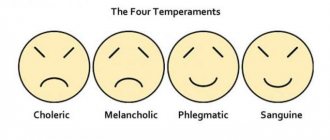Children want to be like their parents or superheroes from movies. Teenagers want to be just like their idols. Adults, as a rule, also look up to someone, but more often in this case we are talking about a collective image of a successful, happy person. All these are examples of identification - the desire of an individual to imitate someone, to be the same as him.
Types of identification
It can be primary and secondary. In the first case, we are talking about the child's identification with the mother, and later with the parent of the same sex as the child. In the second case, the child’s identification with other people and groups in the process of growing up is implied. It, in turn, is divided into several more subspecies. Let's take a closer look.
Situational
This is clearly noticeable in children during games, in adults - at a meeting, when meeting a new person, etc. In general, in some specific situation or conditions, an individual tries to become the same as a person significant to him.
Group
This is a stable type. It implies an individual’s commitment to the values and goals of a group. Outside of it, the subject lives by the same rules. However, sometimes group identity is situational and superficial. A person does not accept the goals and interests of the group as his own. Once he leaves this group, he will behave differently.
Cultural
This is a process of identification, adaptation to the culture of society. A person needs to find a balance between internal and external. For example, between traditions and innovation, goals and means. The subject has to realize his own potential within a particular society. Accept the norms and values of this world.
Social
This is the process of a person identifying himself as an important, active participant in society. He perceives himself as a social agent, feels that he belongs to some social group, and can pronounce “WE” with complete confidence.
Personal
This is a person’s assimilation to himself, that is, the preservation of his uniqueness. Implies unity of goals, interests, views, beliefs, motives, meanings. No matter what group a person belongs to, he always retains a set of stable characteristics.
Finding a balance between personal and public is one of the most difficult problems in psychology. Sometimes a person becomes so similar to others that he loses himself. He dissolves into other people. He forgets about his essence, loses the unity of his Self, ceases to understand himself, forgets his life story.
Collectivist
Formed in the process of general activity. The experiences of one person are transmitted to others and become motives for common activity. Collectivist identification manifests itself in complicity and sympathy. Each team member shares the failures and successes of the other. That is, a person feels others as himself.
Gender
The process of realizing which gender (collective image of a man and a woman) a person considers himself to be. It doesn't always match the gender. Gender identity provides the answer to the question “Who do I feel like: a man or a woman?” At the same time, a person understands perfectly well which gender he belongs to. For example, a man can recognize his gender, but at the same time be vulnerable, sensitive, gentle, that is, have a set of traits that are generally characteristic of women. Likewise, a woman, despite her gender, can feel like a “man in a skirt.”
Development
Since Freud proposed the term and also named the types of human identification (erotic and mimetic), the influence of identification and its role in the formation of personality has been studied by many philosophers and psychologists. Freud, who laid the foundations of the doctrine, called identification with those people whom we would like to possess erotic.
The second type he identified was aimed at the kind of people we would like to be. Through the process of mimetic identification, the crowd becomes controllable, as all its elements abandon their ideals and accept a single, mass ideal expressed in the leader.
The concept of identification is actively used in social psychology. The most original theories are associated with the names of Tajfel and Erikson. Tajfel developed the theory of social identity. Groups to which people belong are a source of pride and self-respect, they integrate a person into the social world and create a sense of belonging to a large group of people.
Recommended: What is personal identification?
The negative aspect of such a process is the attempt to increase one's self-esteem by exalting the group to which a person belongs and painting other groups with black paint. The division into “us” and “them” leads to a decrease in empathy towards the latter
At the same time, it becomes important for us to help and support those who are part of the “we” group
The prejudices that arise in a culture as a result of this division sometimes result in large-scale and violent conflicts. Examples are racism and genocide. Social identification leads to an exaggeration of differences between groups and an erasure of differences within them. Thus, we do not see personalities, individualities behind all this, and we begin to perceive those around us from other groups stereotypically.
Tajfel and Turner identified three stages of identification. We first classify objects to understand and identify them. The name of this stage is categorization. There is nothing wrong with categorization itself, since without it it would be quite difficult for us to live; categories give us quite a lot of information about a person and his roles in the group.
At the second stage, we ourselves begin to attribute ourselves to one of the groups that we identified earlier. And only the stage of social comparison is fraught with threats. When we have already classified ourselves as a member of a certain group and begin to compare it with others, we may be prejudiced against their representatives, especially if our groups compete. To communicate productively and sustainably, you need to clear your thinking of unconscious attempts to denigrate people from other groups.
We recommend: The concept of identity in psychology
Identification is an important term in Erikson's identity theory. To find oneself, to become an individual, a person must make many identifications with others and integrate them. The acquisition of identity is accompanied by an awareness of one’s inseparability from the social and cultural field, the perception of the integrity of the individual, the continuity of its development through identification with different social groups. In his theory, identification is the path to achieving identity.
What is Personal Identification
In psychology, personality identification is understood as a person’s attribution to himself of features, qualities, properties, external signs and internal characteristics of a subject. According to this, he partially or completely transforms himself.
Personal identification is likeness to a person, group, character. This process is called identification. Derived from the Latin word identificare, which means “identification.” Moreover, most often the person himself does not understand that he is adopting someone else’s characteristics. This is why it can be very difficult to distinguish the true “I” from borrowings, which is why we sometimes do not know what it means to “be ourselves.”
Until the age of three, children talk about themselves in the third person, because until this moment they do not identify themselves as an independent person. But from the age of three we begin to actively learn about ourselves: gender, age, nationality, etc. We then begin to accumulate social experiences by identifying ourselves with family and friends. Every year this process becomes more and more difficult, and the risk of losing oneself increases. Individuals completely forget about themselves and dissolve in other people, things, and phenomena.
Identifying yourself with another person is comparing your experience with his experience, building your life similar to his life. “We are so similar”, “I am the same as you” - such phrases can describe the essence of this phenomenon.
Identification of a person by external and internal characteristics
Freud made a special contribution to the study of personality assimilation. He believed that this is an unconscious merging of a person with others, imitation of them. The individual becomes infected, as it were, with other people’s thoughts, emotions, interests, and habits. This is probably why they say “tell me who your friend is and I will tell you who you are.” According to Freud, comparison of a person according to internal and external characteristics occurs by comparing characteristics or by determining the essence (membership in a group).
The process of identifying oneself with others
Identification comes in three levels (stages, types):
- Acceptance of external values. An example is the worship of a star. The fan watches every performance of the idol, perceives every fall and every rise as his own victories and failures. He follows him around the cities, lives his life. Such identification helps to escape from real problems and worries. A person lives according to instructions, a script. Living in a fictional world is comfortable and not scary.
- Acceptance of internal values. These are the “masks” that each of us wears. This is the acceptance of the values of society, imitation of the norms that others promote. Simply put, we hide our essence and appear as specific people in a specific place and time want us to be. There is nothing wrong with this as long as a person understands where the mask is and where he is real, and knows how to manage it.
- Comparison with oneself (self-identification). For example, in a dream we experience and feel everything as if it were happening in reality, but at the same time we understand that this is far from our reality. This is the most difficult and deep level. The level of self-compassion, knowledge and understanding of your body, feelings, desires, subconscious. This is communication with yourself beyond all masks and images.
How to become yourself? It is important to understand your value and realize that each person has their own path to happiness. To be yourself, you need to constantly leave your comfort zone, develop, learn your needs, abilities, interests.
You need to learn to look at yourself from the outside. At the same time, it is important to develop awareness and learn to live here and now. You need to break out of the usual framework of identification, remember what you once were, what you wanted.
We will talk more about identification and self-identification in other articles.
Methods of personal identification using biometric parameters
Fingerprinting
This identification method is the most common. It uses the uniqueness of finger papillary patterns for each person. A special scanner is used to obtain an image of a fingerprint. It is transformed into a digital code and compared with the template entered earlier.
Fingerprinting
The identification process takes no more than a few seconds. A certain disadvantage that hinders the development of this method is the prejudice of some people who do not want to leave their fingerprint data. The counter-argument of the hardware developers is that information about the papillary pattern is not stored, but only a short identification code based on the fingerprint and does not allow the pattern to be recreated for comparison. The advantage of the method is ease of use, reliability and convenience.
Hand shape
Identification by hand shape
This static method is based on measuring the shape of the hand. It is also a unique biometric parameter of a person. A special device allows you to get a three-dimensional view of the brush. The result is measurements to create a unique digital code that identifies a person.
This method in its technology and accuracy is comparable to the fingerprint identification method, although the device itself for implementing the method takes up a lot of space. The likelihood of having two identical hands with the same geometry is extremely low, although hands change with age.
Today, hand geometry identification is used in legislative bodies, hospitals, international airports, etc.
Iris
Iris authentication
The basis of this method is the exclusivity of the pattern on the iris of the eye. To perform this, you need a camera to obtain an image of the eye with sufficient resolution, and special software to extract the pattern on the iris from the resulting image. It is used to create a digital code that serves to identify a person.
The advantage of scanners is that the person is not required to focus on the target, since the pattern of iris spots is concentrated on the surface of the eye. Scanning is possible at a distance of less than 1 m. This is convenient for use, for example, at ATMs.
Structure of the eye
Identification by retina
The retina is scanned using low-intensity infrared light, which is directed to the blood vessels in the back of the eye through the pupil. Retinal scanners are common in security access systems because they have little chance of incorrect access permissions. Errors can be explained by deviation of the head from the reference position and incorrect focusing of the gaze on the light source.
Even twins have different retinal capillary patterns. This is why this method can be successfully used for personal identification.
The disadvantage of such systems is the psychological factor: not every person can look into a dark hole in which something is shining into the eye. In addition, these systems are sensitive to incorrect retinal orientation, so one must carefully monitor the position of the eye in relation to the hole.
Face shape
Face shape as an object for identification
This static identification method involves creating a two- or three-dimensional image of a person's face. Using a camera and specialized software, the contours of the eyes, lips, eyebrows, nose, etc. are emphasized in the facial image. Then the distances between these elements and other parameters are calculated. Using this information, an image is created, which is converted into digital form for comparison.
This method is one of the most dynamically developing areas in the biometrics industry. Its attractiveness is based on the fact that no special expensive equipment is required. A personal computer and a video camera are enough. In addition, there is no physical contact with the devices. There is no need to touch anything or stop, specifically waiting for the system to operate.
Handwriting
Handwriting recognition
The basis for handwriting identification is the uniqueness and stability of this factor for each person. The characteristics are measured, converted into digital form and subjected to computer processing. That is, what is chosen for comparison is not writing as a product, but the process itself.
Two methods of data processing are common: regular comparison with a sample and dynamic verification. The first one is unreliable because the signature is not always the same. This method leads to a large percentage of errors. Dynamic verification involves more complex calculations. This method records in real time the parameters of the signature process itself: the speed of hand movement in various areas, the force of pressure and the duration of various stages of the signature. This excludes forgery, since it is impossible to exactly copy the hand movements of the author of the signature.
Keyboard handwriting
Keyboard handwriting recognition
This method is, in general, similar to that described above, but the signature in it is replaced by a certain code word, and the only equipment needed is a regular keyboard. The main identification characteristic is the dynamics of the keyboard typing of the code word.
According to modern research, keyboard handwriting has a certain stability, thanks to which a person can be unambiguously identified. The initial data is the time between pressing the keys and holding them down. Moreover, the time between pressing shows the pace of work, and holding - the style of work, that is, a smooth press or a sharp blow.
First, at the filtering stage, data on “service” keys – function keys, cursor control, etc. – is deleted.
Then the following user characteristics are highlighted:
- number of errors during the typing process;
- time between keystrokes;
- dialing speed.
- time to hold keys;
- arrhythmia when typing.
Voice
Voice recognition
The biometric voice identification method is easy to use. The reasons for its introduction are the widespread use of telephone networks and the integration of microphones into computers. Disadvantages can be considered factors that influence recognition: interference in microphones, ambient noise, errors in the pronunciation process, different emotional states of a person during identification, etc.
The main thing in building voice authentication devices is the choice of parameters that best describe the individuality of the voice. These signal parameters are called personality traits. Such signs, in addition to data on the characteristics of the voice, must also have other properties. For example, they should be easy to measure and little affected by noise and interference. In addition, they must be stable over time and resist imitation.
Systems have been developed using the method of combined analysis of voice and facial expressions. It turns out that the speaker’s facial expressions distinguish him only and will be different for another person uttering the same words.
Arteries and veins
Thermographic observation of facial arteries and veins
Identification of a person by face is greatly simplified if we move to the infrared range of light waves. Thermography of an identified face reveals the unique location of the arteries on the face that supply the skin with blood. The issue of backlight does not exist for these biometric devices, since they only perceive temperature changes in the face and do not need light. The effectiveness of recognition does not depend on overheating or hypothermia of the face, natural aging of the individual, or plastic surgery, since they do not change the internal position of the blood vessels.
Facial thermography can distinguish between twins whose facial blood vessels are very different.
This identification method uses a specialized far-infrared video camera.
Identification by veins of the arm
Venous system of the arm
There are devices on the biometric market that are based on the analysis of the individual location of veins in the arms. The pattern of veins located on the back of the hand clenched into a fist is taken into account. The pattern of veins is observed by a television camera using infrared illumination. When an image is entered, it is binarized to highlight the veins. Such equipment is produced by the only English company Vinchek.
Prospects for biometrics
The dominant method of personal identification is still fingerprint recognition. There are two main reasons for this:
- in many countries the transition to passports with biometric data has begun;
- development of updated models of fingerprint scanners for use in small devices (cell phones, pocket PCs, laptops).
Significant expansion can be expected in the signature identification sector due to the widespread adoption of digital electronic signatures. Voice recognition may also gain momentum thanks to the implementation of large projects in the construction of intelligent buildings.
The main forecasts are that the introduction of biometric security devices will become an avalanche in the near future. The fight against global terrorism will require the practical use of any achievements in this area. Thanks to the intensive development of multimedia and digital technologies and their further reduction in cost, it will be possible to develop and implement fundamentally new identification systems.
Certain biometric technologies are currently in the development stage and some of them are considered promising:
- facial thermogram in the infrared range;
- DNA characteristics;
- spectroscopy of finger skin;
- palm prints;
- shape of the auricle;
- human gait parameters;
- individual human odors;
- skin salinity level.
These methods of biometric identification today can be considered mature. They may soon move from research to commercial technologies.
Personal identification: features and types
The process of identification is characterized by relative limitations. A person is designed in such a way that he has the ability to liken only those who have at least some similar traits with him. Through identification, an instrument of understanding is developed. It is a kind of mirror, reflecting the general and promoting better communication.
Personal identification is divided into the following types:
1. Situational
This type of identification most often finds its manifestation in children's amusements. Thus, one of girls’ favorite games is still “mother-daughter”, during which the child’s behavior in future family conditions is “rehearsed”.
2. Collectivist
A person often likens himself to the community in which he moves. The individual realizes that he is one of the constituent elements of the collective “puzzle”. The goals and values of a given social group become his own. This is how “corporate” thinking is formed.
3. Personal
In psychological practice, this type of personal identification is considered as a person’s awareness of his own life attitudes and motives of behavior as a subject of activity. This is what characterizes the psychological integrity of the individual, his “self.”
4. Ethnic or national
Due to the fact that each of us lives in a certain culture, we feel an inextricable connection with it. Such an understanding is formed in a person on the basis of emotional comprehension of the peculiarities of the customs and mentality of the nationality to which he belongs.
5. Political
In this case, one observes identification of oneself with a specific socio-political position. A person is aware of his attitudes regarding any party, ideological movement, political institution or leader.
Personal identification using biometric parameters
Biometrics is a set of methods and devices for identifying a person, which are based on his unique physiological or behavioral characteristics.
This type of identification can be used to prevent unauthorized access to buildings, computers, ATMs, mobile phones, and so on.
Biometric properties are:
- fingerprints;
- facial geometry;
- iris of the eyes;
- retinal pattern;
- voice;
- handwriting;
- keyboard typing;
- pattern of veins on the hands, etc.
Science 2.0 Personal Identification
Social identification
Speaking about social identification in psychology largely implies views and attitudes towards the problems of a certain age, class, professional or some other group.
Each person divides society into “us” and “strangers”. In order to maintain good relationships, interact competently and be protected by like-minded people, a person has to share the views on life that this very group preaches.
A person lives with the problems he hears about, even if they do not concern him.
A person does not deceive himself, he listens to the opinions of others, which he considers authoritative, as a result of which he can look differently at certain problems, become in solidarity with his group, or may share them initially.
We constantly ask ourselves: “Why am I with these people? What unites us? Are we really close? Having heard an unusual opinion, we do not immediately reject it, as would happen in a group to which we do not belong.
Example
There are a great many examples of social identification. You know them yourself
Probably everyone has a colleague who is treated with distrust, caution, and, to put it mildly, disliked. As soon as someone “good” comes to the team, he immediately begins to copy this behavior, without even really understanding people, but by “trusting” the society of “his own”
Identification in Freudian philosophy?
The famous Austrian expert on psychoanalysis, Sigmund Freud, created his own concept of this phenomenon. He was the first to identify the following categories of identification:
1. Anaclitic
This type of mental reaction is characteristic of children who identify themselves with a parent who supports and helps them. For example, if a mother shows maximum attention and tenderness towards her child, then the child will ultimately want to be just like her.
2. Identification with the aggressor
The Austrian psychologist viewed this category as an automatic reaction caused by the need for protection from the influence of a person with more power. So, if a child is afraid of his father’s punishment, he subconsciously strives to become like his parent. In this case, the child thinks, he will have the same influence and the same power.
In psychological practice, there are often cases when a patient identifies himself with the specialist treating him. Freud warned his colleagues against the narcissistic temptation to imagine themselves as the all-powerful “saviors” of their clients. Despite this, this taboo continues to be violated more often than other therapeutic prohibitions.
Conclusion
Identification gives us the opportunity to better understand other people by putting ourselves in their place. Many phenomena of the surrounding world are difficult to perceive individually. A person needs to compare himself with a specific image, which is achieved through identification.
Empathy
Over time, a person will move away from his parents and may adopt the behavior and character traits of literary heroes. Bravery in extreme situations, honesty, valor, etc. can be the merit of the books on which a child or teenager was raised. I have a separate article about what empathy is.
The impact of films is weaker, since the period of their influence on the human psyche is short-lived. Identifying with the hero of a work of art helps to better understand the work and evokes vivid emotions and experiences.
At a young age, many girls show a penchant for reading romantic literature. From books they learn more about how true ladies behave, as a result of which they themselves develop such traits as morality, delicacy, and femininity.
You can use the desire for identification for your own purposes. For example, during a divorce, it is recommended to read books about strong women, or heroic epics to develop self-confidence.
By the way, all this is written very interestingly in Yulia Fomina’s book “Psychological characteristics of fairy-tale characters and personal identification.” It tells exactly how fairy tales influence a child and what consequences they lead to in adulthood. Who knows, maybe in this work lies the answer to the question: “Why am I like this?”
How criminologists identify a person: methods, methods, examinations
Every detective lover dreams of being in the shoes of Sherlock Holmes: investigating mysterious crimes, noticing the smallest details at a glance, putting facts together into a single theory, showing deductive resourcefulness and brilliantly exposing criminals. But what methods do real “brilliant detectives” use? And what science are they studying?
Forensic science deals with the development of methods for investigating crimes. And since the goal of any investigation is to identify the culprit, the task of forensic science is to provide the maximum amount of information about the identities of the victim and the criminal. There are various methods of personal identification. The simplest one is to compare information from documents and information obtained as a result of a forensic medical examination. If doubts arise about the accuracy of the documentary data, an identification procedure is carried out - witnesses are brought in to establish the identity. However, when the impartiality of witnesses is not guaranteed, criminologists resort to more sophisticated methods.
Fingerprinting is the most popular way to identify a criminal, thanks to detective novels and crime dramas. This is a fingerprint identification method.
Krimi
Back in the 17th century, scientists classified patterns on the skin of fingers into three types: arched, looped and whorled. The papillary pattern is formed in the thirteenth week of fetal development in the mother’s womb; it is unique and inimitable for each person. There is a misconception that identification by fingerprints can be avoided by deforming the pattern: burning the skin on the fingers, erasing it or cutting it off. But in the case of chemical or physical exposure, scars appear on the limbs, which can also be used to easily identify a person when fingerprints are taken. As a rule, the pattern on the skin of the feet is less susceptible to deformation, so criminologists often examine papillary patterns on the heels and compare the results with the data available in the database.
The following forensic method is actively used by archaeologists. The osteometric method of personal identification allows us to calculate the age, gender, and physiological characteristics of a person from bone remains. Researchers focus on the skull and pelvic bone.
Krimi
The skull is formed in the embryo already in the second week of development. In the mother's womb, the body does not need to breathe and chew food, so the newborn's skull has a special configuration: the brain is almost 9 times larger than the facial region in volume, the jaws, especially the alveolar processes, are underdeveloped. Subsequently, the skull is modified, the child acquires more pronounced individual features.
Krimi
In an adult, the volumes of the brain and facial sections are correlated as 2 to 3. Based on the visual characteristics of the facial section, gender can be determined: as a rule, men have a more massive lower jaw, weighing 80 grams or more, the occipital protuberance and superciliary arches, eye sockets protrude forward have a rectangular shape. The female skull is more graceful: the lower jaw weighs less than 65 grams, the occipital protuberance is more flattened, and the eye sockets are round. In men, the facial region is more developed than in women, and the skull itself is 100-200 cubic centimeters larger.
Let’s imagine: a conventional criminologist, V., discovered a corpse, the circumstances point to suicide. While examining the scene of the alleged crime, criminologist V. found a bloody mark on the tiles and hair on the floor. He took the biomaterial for molecular genetic testing and found out that blood cells and hair have different genetic composition: the blood belongs to the victim, the hair belongs to an outsider. If the biomaterial is taken from one person, the cells will have the same genetic composition.
Molecular genetic testing helps to establish blood relationship, race and gender, using a minimal amount of biomaterial. The most commonly used are blood, hair, seminal fluid, and the epithelium of the inside of the cheek. The genetic composition of any organism is unique, and the composition of cells in one organism is identical.
Cells contain hereditary material - a genome (DNA molecules), consisting of 23 pairs of chromosomes, 22 pairs contain information about the characteristics of a person’s appearance, psyche, and physiology.
To carry out the examination, a certain region of the chromosome is examined, which consists of a short (from 2 to 6) or long (from 7) sequence of nucleotides. Tandem sections are repeated. Short tandem repeats (STRs) are subject to study, since long tandem repeats can degrade under the influence of chemicals or radiation. Based on the number of repeating tandems in a certain area, a person’s genetic profile is formed.
For identification using DNA material, about 30 sets of nucleotides are standardized, in which the number of repeats is unique. Based on these kits, international DNA test standards were created - CODIS, ESSS, UK Core Loci.
Each person receives 50% of their genetic material from their mother and 50% from their father. Establishing kinship is possible by comparing genetic profiles “vertically” (parent-child): mother-son, mother-daughter, father-son, father-daughter. To do this, the number of tandem repeats in each allele is compared. If alleles that are not characteristic of the father or mother are found in at least two nucleotide sequences, the relationship is not confirmed. To confirm the relationship, the probability rate must exceed 99.90% if both parents and the child participated in the test. If the biomaterial is obtained from a child and only the father (only the mother), the probability should reach 99.75%.
With the development of technology, forensic methods practically do not allow errors, which speeds up the investigation and makes its results more reliable.
Author: Ksenia Luzhenkova
Photo:
1. Fingerprinting
2. Variety of papillary patterns https://avatars.mds.yandex.net/get-zen_doc/1637352/pub_5e0eef9ebd639600b1326df0_5e0ef66906cc4600afee2584/scale_12003.
3. Baby and adult skull
4. Male and female skull
Sources:
- Kovalev A.V. – NON-TRADITIONAL METHODS OF PERSONAL IDENTIFICATION IN FORENSICS // Law Institute of National Research Tomsk State University https://ui.tsu.ru/wp-content/uploads/2016/05/kovalev-av.pdf
- Sechenov University https://www.sechenov.ru/upload/iblock/514/5148cef19122863a5dd24f6a2b0013d6.pdf
- Popov V.V. — PERSONAL IDENTIFICATION BY MOLECULAR GENETIC METHODS // Rostov Law Institute of the Ministry of Internal Affairs of Russia https://cyberleninka.ru/article/n/identifikatsiya-lichnosti-molekulyarno-geneticheskimi-metodami/viewer
What does the concept of identification include?
Identification is the identification of oneself with another person, character or even a group of people, as well as further unconscious assimilation.
A person lives in society and encounters other “characters” in whom he sees traits and qualities that are not characteristic of him. To make communication easier, a person takes on some characteristics. The more we come into contact with a certain person, the more we absorb from him. This is a defense mechanism that allows you to avoid conflicts. This is relative to other people.
When we look inside ourselves, we can see many people.
You can identify yourself not only with a real person. Some qualities are adopted from books. The human psyche is aimed at constant self-improvement; we unconsciously strive to become better, and for this we need to have an idea of the ideal. These may be in books.
Identification can also be cultural, ethnic, collective, but I would like to start, of course, from childhood.
Identification in criminology
Criminologists understand identification as the identification of a wanted criminal. In the process of operational-search activities (OPM), specialists use several identification methods at once.
Identification in criminology is the identification (establishment) of a person based on dynamic and static characteristics. The first includes facial expressions, speech, gestures, and gait. The second includes fingerprints, smell, composition of biological fluids. Sometimes for identification they use a sketch compiled from the words of witnesses, a photograph or a computer model of a person.
Conditions for the identification procedure:
- Preservation of the rights and freedoms of all participants.
- Maintaining the safety of witnesses, maintaining secrecy.
- Drawing up a report, extract, certificate on the results of the event.
- The final document describing the conditions under which identification took place and the signs of compliance. Audio, video and photographic materials are included.
Personal identification can take place in natural or artificial conditions. That is, in those places where the suspect should appear or at the police department.
Benefits of biometric identification
Biometric security is more effective than, for example, using passwords, smart cards, PIN codes, tokens or public key infrastructure technology. This is explained by the ability of biometrics to identify not a device, but a person.
Conventional security methods are fraught with the loss or theft of information, which becomes open to illegal users. An exclusive biometric identifier, such as fingerprints, is a key that cannot be lost.
Classification of biometric methods
Based on the type of information used, biometric identification is divided into:
- Static methods based on the unique properties given to a person from birth and inherent in him. Physiological indicators (the geometry of the palm or the papillary pattern of the fingers) are unchanged for humans'
- Dynamic methods based on the behavioral (that is, dynamic) characteristics of the individual. These features are characteristic of subconscious movements when reproducing any actions (speech, signature, keyboard dynamics). Such behavioral characteristics are influenced by controllable and not very controllable mental factors. Due to their variability, biometric samples must be updated as they are used.
Next, we will consider methods of biometric identification corresponding to the types of information being processed.
Identification mechanisms in psychology
Identification mechanisms come in various forms. For example, imitation, identification, immersion in the world of another person, the potential opportunity to do so, and so on.
We dissolve into each other.
The entire internal and external world of a person can be identified: worldview, character traits, motives, interests, goals, and even manners of behavior and communication.
If you haven’t seen a friend for a long time, but have a good memory and observation skills, you may notice how, for example, he began to do things unusual for him - fiddling with his lips, squinting or speaking through his nose. Ask who of his friends does this, and you will find out the name of the person he is targeting.
What does identification mean in forensics?
This is a determination of the identity of a person based on general and specific characteristics, for example, fingerprints and handwriting. In addition to identifying individuals, criminologists are engaged in identifying objects:
- seals based on impressions;
- weapons by bullets, cartridges;
- shoes on the tracks;
- tools for burglary or other crime in the wake of burglary or other crime;
- car following wheel tracks;
- other.
The whole is also identified by its individual parts.
Identification methods
To determine identity, criminologists use static and dynamic methods. The first includes the analysis of the biological and physiological characteristics of the individual:
- palm print, fingerprint;
- shape, features, proportions of the face;
- drawing of the retina, iris;
- height, body proportions, size of arms, legs;
- handwriting, signature.
Most often, dactyloscopy (fingerprint analysis) and identification of a person by appearance are used:
- thickness, length, other features of the limbs;
- back features;
- breast specificity;
- characteristics of shoulders, neck;
- wrinkles;
- shape of the auricle;
- teeth;
- height;
- weight;
- lips;
- nose;
- eyes;
- brows;
- forehead;
- face;
- hair;
- floor;
- age;
- general body type;
- head.
Dynamic methods include the analysis of everything related to behavior:
- speech,
- facial expressions,
- gestures,
- poses,
- gait,
- voice,
- posture.
Identification stages
The identification process in forensics takes place in several stages:
- Preparation. The expert studies everything that was provided to him for research: the resolution, documents, etc. He evaluates the volume, suitability, and reliability of materials. If everything is normal, then the specialist draws up a research plan, selects methods, and prepares technical means. If something is missing for the study, the specialist submits additional requests.
- Analytics. The expert studies the signs and properties of all objects and subjects.
- Experiment. Needed to obtain samples of the objects being studied.
- Comparison. Direct identification of objects.
- Generalization, conclusions, recording of results. Determining correspondences, similarities and differences.
The results are recorded in a written document. Otherwise, the identification results cannot be considered valid. The expert's opinion consists of several parts: introduction, research, conclusion.
Identification - what is it?
Translated from Latin, this term means “identification.” To identify oneself with another means to focus on its stable parameters and, depending on this, “tune” one’s personality. Experts break down the definition of identification into the following components:
- building an emotional connection: implementing another person’s feelings into one’s own inner world, accepting his life guidelines and values;
- projecting oneself onto this individual, seeing him as a continuation of one’s personality, giving the interlocutor the characteristics of one’s character, desires, feelings;
- “putting” oneself in the place of a partner: imaginary relocation into the world of another individual to assimilate his motives of behavior.
The term “identification” is also used by psychologists when an individual “gets used to” the image of a literary or cinematic character. In this case, empathic experiences and mental reincarnation arise.
Who among the boys in childhood did not want to try on the role of the fearless and noble d'Artagnan - the hero of the immortal novel by A. Dumas? Is there really a girl who doesn’t dream of a handsome prince and doesn’t imagine herself as a meek Cinderella or faithful Assol?
Basic principles of describing appearance using the “verbal portrait” method
In forensic practice, it is customary to record data about a person’s appearance through a description, which can be disordered and ordered. Eyewitnesses usually talk about the appearance of the person they saw in any form, using words and expressions depending on their life experience, education, etc.
An ordered, systematized description in criminology is called a “verbal portrait.” Such a description makes it possible to uniformly characterize the same signs and to perceive these descriptions in the same way by different people. Uniformity is achieved by observing the basic principles of describing appearance:
1. Maximum completeness of description. This is achieved through a comprehensive characterization of the structural elements of the head, face, torso, limbs, clothing, etc.
2. Strict sequence of description (from general to specific). In a person’s appearance, first, general physical properties are distinguished, such as gender, age, nationality, and then physique - torso and limbs, head (face) and its individual parts; functional signs; clothing and special signs.
3. Use of special terminology. Compliance with this principle makes it possible to eliminate discrepancies in the characteristics recorded in the descriptions, ensure uniformity and accuracy of the description, and prevent errors. Do not include unclear or vague terms in the description.
4. Description of the parts of the head (face) from the front and in profile. When describing elements of appearance, special attention is paid to the head (face), as the area containing the largest number of diverse stable features that can be observed under various conditions.
To do this, the external anatomy of the head is studied from two positions: from the front, i.e. front and in profile, i.e. on the side. When fixing profile features, it is customary to consider the right profile. However, special features are described on both the right and left sides of the face.
5. Description of individual parts and details of the body, indicating their size, shape (contour), position, color (if possible) and features.
The size of a body part is determined, as a rule, by visually comparing the sizes of one element to the sizes of other parts and details of the body. For example, the size of the auricle is assessed relative to the size of the head, the height of the forehead - relative to the height of the nasal and oral parts of the face. To describe the size, a three-member system is used: small, medium, large; sometimes five-membered: very small, small, medium, large, very large.
When describing the shape (contour) of body parts, the terminology of well-known geometric shapes is used - convex, concave, flat, round, square, etc. or natural objects - dome-shaped, almond-shaped, pear-shaped, etc.
The position of external features refers to their placement relative to a horizontal or vertical line, other elements (for example, a fold on the chin), and sides of the human body (front, back, top, bottom, etc.). By position, external elements can be characterized as horizontal, vertical, beveled, protruding, oblique, internal, lowered, adjacent and protruding.
Color is indicated in relation to eyes, hair, facial skin, scars, birthmarks, tattoos and other special features. Color is expressed in generally accepted terms (black, white, red, etc.).
What types of similarity exist?
Psychologists have not yet come to a consensus on what the term “identify” includes; the meaning can be quite voluminous. Freud in his works pointed out that the identification of a person by external and internal signs occurs either by establishing the equivalence of taking into account signs (for example, identifying criminals), or by defining the essence, i.e. belonging to a certain group.
The psychologist also believed that identification is an unconscious action of merging an individual with other people in whole or in part, i.e. a kind of imitation. Such identification means infection with other people's thoughts and ideas, getting used to the emotions of the object of imitation.
We recommend: What is an alter ego?
Modern psychologists distinguish three types of identification. The first is the most common and means merging with external values. For example, you really like a famous figure skater, you watch all his performances, worry about every injury or fall on the ice. Any reward for your idol is your reward, his failure is your failure. You become so accustomed to the new image that you no longer feel the difference between yourself and this person.
Identification with internal values means that a person is completely immersed in the system of conventional coordinates “good - bad.” In other words, each of us has a true character and individual traits, which, under the influence of upbringing, are transformed into something different that meets the requirements of society.
A person puts on a mask facing others and considers this normal. But as soon as the mask encounters the inner “I,” the true values are replaced by the conditional values of the mask.
Identification with one’s own personality is the third level. For example, some people quite often have vivid, eventful dreams; they completely sincerely empathize with themselves, take everything that happens at face value, and completely merge with the character of the dreams.
However, upon awakening, they realize that it was just a dream, the reality around them is a completely different matter. This level of identification is the deepest; it consists of identifying oneself with the body, personality, feelings, secret desires, aspirations, without masks and roles imposed from outside.
Collective identification
Collective or group identification arises depending on the society in which a person finds himself. The desire for success, study or destructive behavior also does not arise out of nowhere. A child or an adult, communicating in certain circles, may deviate from a given course, the concepts of good and evil are blurred or replaced by others.
Single friends of a recently married man may be surprised by his changes and complain about his wife’s influence. In fact, this is a vital mechanism in which there is nothing reprehensible or unnatural. As they say, we will all be there.
Example
I once had to communicate with a young man who cheated on his own wife only because all his friends did so. They often got together and discussed victories on the love front. Cheating did not make my friend happy, nor did communicating with his friends, whom he could not refuse.
The woman is getting married.
How many women get married or give birth just because all their classmates have already done the same?
In fact, it can be very difficult to resist authoritative opinion, since our brain strives for an ideal life, the images of which it captures in the surrounding society.
No matter how much they laugh at the owners of Apple products, as soon as a person has the opportunity, he most often buys equipment from this company.
Social identification
A person has a deep need for recognition of his inner beliefs by society. In certain situations, an individual needs to protect “his own” against the unfavorable circumstances of the surrounding world. The cementing element is the commonality of mentality traits of an individual participant in society and a group.
The inability to socially identify has a negative impact on the psychological health of the individual. If a person notices that the group to which he belongs is valued low by society, he begins to develop the following patterns of behavior:
1. “Internalization of a devalued image”
Using this strategy, the individual resignedly accepts himself as “bad.” He refuses to protest and seems to be trying to go into the shadows so as not to “be an eyesore.” At the same time, the person pretends not to notice how society discriminates against him on certain grounds. He capitulates without taking any measures to improve his situation.
2. Aggressive resistance
In this case, one identifies oneself as an active “fighter for justice.” A person chooses a protest line of behavior and counterattacks those who express dissatisfaction or contempt towards him.
As a rule, such an individual adopts ridicule or reciprocal disdain for the foundations of critics. He can also act on the principle “the worse, the better” and emphasize in his behavior precisely those traits that are negatively perceived by the dominant culture.
3. Assimilation
Having chosen this path, a person strives to get out of the image repelled by society and become “like everyone else.” The search to determine the identification of one’s person and dominant ideas can be observed in various planes: from adapting the image to general ideas to radical measures, for example, changing the name. By adapting to others, the individual thus betrays the group to which until recently he belonged.
4. Compromise
This strategy has a second name - “creating a critical personality.” A person does not renounce “his own,” but acquires some features characteristic of the prevailing belief system. He may accept some negative assessments of his community and disagree with others.
Description of a person's appearance
To identify a person, anatomical and anthropological signs are used that characterize the external appearance of the human body as a whole and its individual parts, as well as some functional signs and anatomical and pathological changes (special features). Various signs of clothing and other things and objects that a person constantly or often uses are studied.
Description of anatomical features
Floor. Male, female.
Age. It is established on the basis of reliable data, and in the absence of data, approximately, “by sight.” The following age periods are distinguished: children - up to 12 years; teenage - 13-16 years old; youthful - 1721; young - 22-35 years old; average - 36-60 years; elderly - 61-75 years old and senile.
Nationality (face type). In the absence of reliable data, a comparative determination of the type of person is allowed. In forensic science, European, Mongolian, Caucasian and Central Asian facial types are distinguished.
Height. It is determined, as a rule, by a three-member gradation. For men: low - up to 160 cm; medium - up to 170 cm; high - up to 180 cm and above. For women, these limits are reduced by 8-11 cm.
Body type. It is determined by comparing height, shoulder width, length of the torso, legs, development of the chest and shoulder girdle muscles, taking into account the subcutaneous fat layer. There are people with athletic, stocky, average and weak builds. In terms of body fat, a person can be characterized as thin, of normal nutrition, or overweight.
Head. In relation to the body, the head can be small, medium and large; The shape of the parietal part is flat, dome-shaped, ovoid. The position of the back of the head relative to the vertical is beveled, vertical, and protruding. The face as a whole is described by its general configuration: round, oval, triangular, square, rectangular, diamond-shaped.
Hair. When describing hair, their presence, configuration, hairline, length, type of hairstyle (haircut) or degree of baldness are noted. Then a description of facial hair (mustache, beard, sideburns) is compiled.
Forehead. The description of the forehead is done in profile and from the front. In the profile, its inclination (position) from the vertical is noted: vertical, tilted forward and tilted back (Fig. 13.3.). The width of the forehead can be wide, medium and narrow, and the height - high, medium and low. A significant protrusion of the brow ridges and the presence of frontal tubercles are also recorded.
Brows. With respect to the horizontal, eyebrows are distinguished into oblique, horizontal and oblique. The criterion in this case (as in other cases) is a deviation from the horizontal by more than 5°. According to their position relative to the eyes, eyebrows can be high, medium and low. Along the contour of the upper edge, the eyebrows can be straight, arched, curved, broken, triangular.
Eyes. When determining the characteristics of the eyes, the following are distinguished: the structure of the palpebral fissure, the protrusion of the eyeballs in the orbits, the color of the iris. The palpebral fissure is described along its contour (oval, round, triangular, slit-like) (Fig. 13.4.); degrees of disclosure (medium, large, small); relative position of the corners of the eyes (horizontal, oblique internal, oblique external). Based on the position of the eyeballs in the orbits, eyes are distinguished between convex and sunken.
Eyelashes. Marked: length (long, medium, short), contour (straight, curved).
Nose. In relation to other elements of the face, the nose can be large, medium or small. The overall size of the nose depends on its height, width and protrusion. The height is determined in profile by the distance from the deepest place of the nose to the lower edge of the nasal septum. The nose can be medium, large (long) and small (short). The width of the nose is determined between the extreme points of its wings. Based on this parameter, a nose is distinguished between narrow, wide and medium. In terms of protrusion, the nose can be strongly, moderately and slightly protruding. The contour of the bridge of the nose is remembered quite well by eyewitnesses. In forensic science, it is customary to call the contour of the bridge of the nose straight, convex, concave and tortuous. The base of the nose can have three positions relative to the horizontal: raised, horizontal, lowered.











